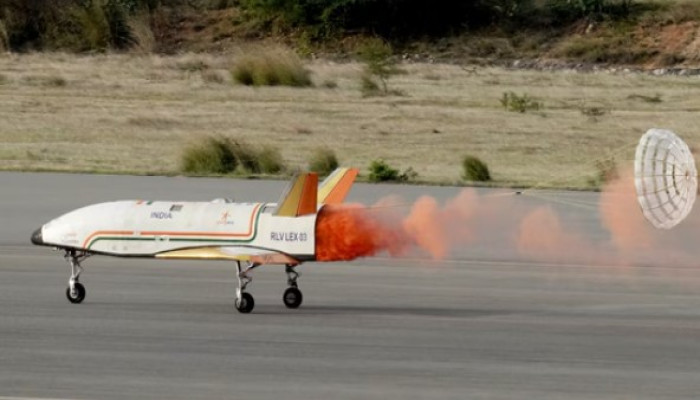ISRO successfully completes final landing experiment of reusable launch vehicle 'Pushpak'
- In Reports
- 11:22 AM, Jun 24, 2024
- Myind Staff
The Indian Space Research Organisation (ISRO) successfully conducted the third landing experiment of the Reusable Launch Vehicle (RLV LEX-03), named ‘Pushpak’. The space agency reported that the test took place at the Aeronautical Test Range (ATR) in Chitradurga, Karnataka.
"ISRO has achieved a hat-trick in the Reusable Launch Vehicle (RLV) Landing Experiment (LEX)," the space agency announced on X. On June 23, 2024, ISRO successfully completed its third and final landing experiment with the RLV named 'Pushpak'. The vehicle executed a precise horizontal landing, demonstrating advanced autonomous capabilities under challenging conditions. With the objectives of RLV-LEX accomplished, ISRO will now proceed to the next phase, the RLV-ORV, the orbital reusable vehicle.
ISRO Chairman S. Somanath congratulated the team for their dedication in maintaining a streak of success in these complex missions. J. Muthupandian served as the Mission Director, while B. Karthik took on the role of Vehicle Director for this mission.
The aim of this mission was to replicate the approach, landing interface, and high-speed landing conditions for a vehicle reentering from space. This highlights ISRO's proficiency in acquiring crucial technologies for the development of Reusable Launch Vehicles (RLV).
As a result of this mission, ISRO has validated a sophisticated guidance algorithm that addresses longitudinal and lateral plane error corrections. This algorithm is vital for future Orbital Re-entry Missions.
The RLV LEX-03 mission, named 'Pushpak,' builds on the successes of the previous RLV LEX-01 and LEX-02 missions. It demonstrated the autonomous landing capability of the RLV under more challenging conditions.
The winged vehicle 'Pushpak' was released from an Indian Air Force Chinook helicopter at an altitude of 4.5 km. Pushpak autonomously executed cross-range correction manoeuvres from a release point 4.5 km away from the runway, approaching and landing precisely at the runway centreline.
Due to its low lift-to-drag ratio aerodynamic configuration, Pushpak landed at a velocity exceeding 320 kmph. In comparison, commercial aircraft typically land at 260 kmph and fighter aircraft at 280 kmph.
After touchdown, the vehicle's velocity was reduced to nearly 100 kmph using a brake parachute. Following this, landing gear brakes were employed for further deceleration.
During the ground roll phase, Pushpak autonomously maintained a stable and precise roll along the runway, utilising its rudder and nose wheel steering system.
The RLV-LEX mission employed multisensor fusion including inertial sensors, radar altimeter, flush air data system, pseudolite system, and NavIC. Reusing the winged body and flight systems from the LEX-02 mission without modification demonstrated ISRO's capability in designing reusable systems for successive missions.
Led by Vikram Sarabhai Space Centre (VSSC), the mission was a collaborative effort involving ISRO centres like SAC, ISTRAC, and SDSC-SHAR, with support from Indian Air Force (IAF), Aeronautical Development Establishment (ADE), Aerial Delivery Research and Development Establishment (ADRDE), and others. S. Unnikrishnan Nair, VSSC Director, highlighted the success enhances ISRO's confidence for future orbital re-entry missions.
Image source: ISRO Twitter







Comments